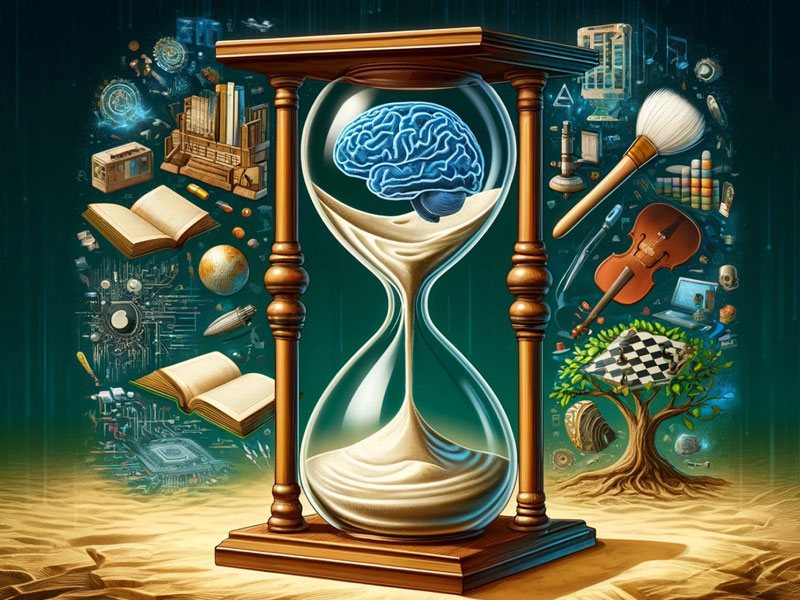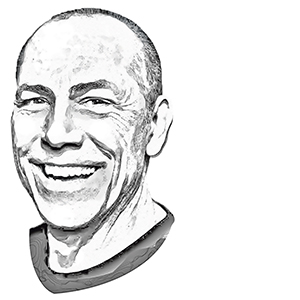The rapid advancement of generative AI is challenging long-held notions of expertise and mastery. The traditional belief, epitomised by Malcolm Gladwell’s ‘10,000-hour rule’ that expertise demands extensive practice, is being upended by AI’s capability to produce high-quality outputs, both creative and technical, with a minimum of human input. This demands reevaluating the skills and knowledge that will remain valuable as AI begins to automate, thereby devaluing some complex cognitive tasks.
The rise of generative AI is not just another technological advancement; it’s a seismic shift that will fundamentally reshape the landscape of cognitive work. As AI systems become increasingly capable of automating complex tasks, the nature of what it means to be an expert will be called into question. The days of relying solely on practiced mastery are numbered, and those who fail to adapt risk being left behind.
It is crucial to recognise that AI is not a replacement for human intelligence but rather an augmentation. While this technology will be disruptive across many fields, herein lies opportunity. As AI takes over more routine and repetitive tasks, the skills that will be most valuable in the future are those that enable effective human-AI collaboration.
This includes thinking critically, asking the right questions, and providing the contextual understanding and ethical guidance that AI systems lack. It also involves developing new forms of creativity, such as imagining novel use cases for AI, designing compelling prompts to guide its outputs, and combining its insights in innovative ways.

What, then, is the role of education in a world where subject mastery and acquiring knowledge skills are rapidly losing value? While challenges surrounding cheating and plagiarism are getting most of the attention in the field of education, perhaps new opportunities should be the focus of our attention as we look to adapt higher education to this uncertain future.
From creativity to curation
For one striking example of a new tool that promises both opportunity and disruption, consider the development earlier this year of Sora, an AI model capable of creating videos from textual descriptions. This represents a quantum leap in the field, as it can generate visually complex and coherent videos in minutes. This task typically takes human creators days, if not weeks, to accomplish.
Traditionally, mastering video production required extensive training, expensive equipment, and a deep understanding of storytelling techniques, visual aesthetics, and post-production processes. However, with Sora, individuals will create professional-grade videos without any of these things, democratising the creative process and dramatically lowering production costs and barriers to entry.
As unsettling as these incursions are to the sanctity of human creativity and hard-won mastery, we can look to the history of the arts and sciences in the face of similar disruptions in our history.
The concept of authorship has undergone a significant transformation over the past two centuries. The 19th-century notion of the artist as a solitary genius gave way to a more complex understanding of artistic agency and originality in the early 20th century, as avant-garde artists and literary figures challenged traditional notions of authorship by introducing randomness, appropriation, and collaboration into the creative process.
These experiments, which blurred the lines between artist, audience, and environment, resemble how modern AI systems ‘remix’ vast corpora of training data. As a result, the current generative AI revolution raises profound questions about creativity and attribution across all disciplines.
When an artwork is the product of a complex collaboration between humans and machines, it challenges our fundamental notions of intellectual property, creative ownership, and copyright law, prompting us to reconsider who can claim to be the “author” in this new paradigm.
In the aftermath of Sora, the artist’s role begins to look much more like that of a curator – to produce new works with a strong viewpoint, artists will need to develop a fast and efficient sense of how to evaluate and subsequently modify the outputs from these systems.
Film editors have already developed a rich body of knowledge and practice around cutting scenes together to support a narrative. What adjacent skills must now be invented, refined, and mastered to utilise AI systems like Sora effectively in the creative process?
One essential skill will be critically assessing AI-generated video content’s emotional resonance and narrative coherence. While Sora can generate visually compelling scenes based on textual descriptions, it may not inherently understand the emotional arc or pacing required to tell a powerful story. Artists must develop a keen eye for identifying which generated scenes effectively advance the narrative, convey the desired emotional tone, and maintain consistency with the overall vision for the work.
Another important skill will be refining and directing the AI system toward desired outcomes iteratively. This may involve generating multiple scene variations, each with slightly different prompts or parameters, and then selecting and combining the best elements
It may also require providing the AI with additional context, constraints, or feedback to guide its outputs towards more coherent and purposeful results. The artist becomes not just a selector of pre-generated content but an active collaborator in the creative process, shaping the AI’s outputs through strategic interventions and guidance.
In the same way that recording technology profoundly changed the places and ways music was received and interacted with, there will likely be new modalities for all of the arts in the wake of generative AI. Just as the advent of recording allowed music to be experienced in private homes, cars, and personal devices rather than solely in live performances, AI-generated art alongside new delivery technology (like Apple Vision Pro) may lead to entirely new contexts and formats for experiencing visual art, literature, and film.
AI collaboration and critical thinking
Effective human-AI collaboration requires a unique blend of critical thinking, contextual understanding, and the ability to ask the right questions. In this new paradigm, humans must learn to think critically about the inputs they provide to AI systems and the outputs they receive.
This involves understanding AI’s strengths and limitations, identifying potential biases or errors in its outputs, and knowing when and how to intervene to guide the system towards more accurate or appropriate results.
Curation in the age of AI is not just about selecting the best individual outputs but also about understanding how these outputs relate to each other and the broader context in which they are being used. This requires skills in pattern recognition, information synthesis, and creative problem-solving. By combining and remixing AI-generated content in novel ways, humans can create value beyond what humans or machines could achieve alone.
In STEM fields, AI offers the prospects of collaborative research and design. For example, AlphaFold, developed by DeepMind, is an AI program that predicts protein structures from their amino acid sequences. Previously, this task was challenging for scientists, often requiring years of experimentation to produce gradual progress.
Before AlphaFold, after decades of effort, scientists had predicted the structure of about 17 per cent of the cataloged proteins known to science. In collaboration with scientists, in the course of only a few months, AlphaFold has made predicted structures available for nearly all of them.
Software engineers will shift from line-by-line coding to collaborating with AI systems that become increasingly adept at writing clean, efficient code based on high-level prompts. This calls for a fundamental reexamination of programming languages and the philosophies underpinning them.
Alan Kay, a pioneer in object-oriented programming, famously advocated for a “turtles all the way down” approach to computing – the idea that complex systems should be built upon layers of abstraction, with each layer being simple and understandable. In a world where AI takes on more low-level implementation, programming languages may need to evolve to prioritize expressive power, composability, and ease of reasoning.
New pedagogy
Traditional pedagogy emphasising memorisation and note-taking was already fading in relevance; AI will accelerate that decline. Instead, universities have a unique opportunity to harness the power of AI and reimagine the learning experience.
Imagine AI-powered learning companions that adapt to each student’s thought processes, providing metacognitive guidance as they solve problems. AI tools could revolutionize history education, for example, allowing students to interact with primary sources, analyze historical patterns, and even experience counterfactual scenarios that deepen their understanding of causality and contingency.
Universities must cultivate the skills and competencies that will remain uniquely human in an AI-driven future – skills such as creativity, emotional intelligence, critical thinking, and adaptability.
This will require a fundamental shift towards more experiential, project-based, and interdisciplinary forms of learning that empower students to think critically, solve complex problems, and continually update their knowledge and skills in an increasingly interconnected and rapidly evolving workplace by emphasizing cross-functional collaboration and exposing students to various perspectives.
Here are a few ideas for new educational experiences that could be created using AI in the very near future:
- AI-Powered Learning Companions: Imagine an AI that deeply understands a student’s thinking patterns, strengths, weaknesses, and preferred learning modalities (visual, auditory, etc.). It tailors instruction in real-time, guiding learners through the knowledge-building processes that work uniquely for them.
- Metacognitive Coaching: AI could track a student’s problem-solving approach and emotional state during learning. It would intervene with content and metacognitive strategies, prompting reflection, suggesting alternative approaches, or providing encouragement when frustration arises.
- ‘Provocative Failures’: Could we intentionally design educational AI that makes flawed but insightful mistakes? This would prompt students to critically evaluate AI output, leading to a deeper understanding of both the algorithm and the subject domain.
- ‘Dialogue’ with AI Philosophers: Could we train large language models on historical, philosophical writings to a point where they generate plausible text echoing a specific thinker’s style and line of reasoning? Students could engage in a “Socratic dialogue” with an AI version of Plato or debate the nature of consciousness with a simulated Descartes. We can see this approximation in a recent Reid Hoffman YouTube video, in which he engages in a thought-provoking dialogue with an AI model trained on his writings, speeches, and interviews.

The role of universities in the AI era
Throughout history, universities have played a pivotal role in driving societal progress, fostering innovation, and nurturing the brightest minds of each generation. These institutions have been the heart of intellectual discovery, discourse, and enlightenment.
Now, as the rapid advancement of AI technology revolutionises the landscape of knowledge and education, universities once again find themselves at a critical juncture.
To thrive in the AI era, universities must fundamentally reimagine their approach to education. The traditional model of passive lectures and rote memorisation is no longer sufficient to prepare students for the challenges and opportunities ahead. Instead, universities must embrace a transformative shift towards experiential, project-based, and interdisciplinary learning.
AI offers the potential to eliminate language barriers, allowing deep cultural and historical input from local researchers and cultural pioneers to be shared globally. This democratisation of knowledge enables people to access the secret parts of history and culture that were previously inaccessible due to language constraints. Universities should lead the way in using the tools to expand and democratise research and education.
Universities have a crucial role in supporting students as they navigate the uncertainties of the AI job market. With many traditional career paths likely to be disrupted by automation, students will need guidance in identifying and preparing for the emerging roles and industries of the future.
Universities can support this by forging close partnerships with industry leaders, offering mentorship and networking opportunities, and creating environments that foster entrepreneurship and innovation. By empowering students to be proactive and adaptable in their career planning, universities can help ensure their long-term success and resilience in a rapidly changing world.
As we stand on the precipice of this new era, the role of universities has never been more critical. The emergence of disruptive technologies like Artificial General Intelligence (AGI) is no longer a distant possibility but an imminent reality.
AGI, with its potential to match or surpass human-level intelligence across various domains, could fundamentally reshape every aspect of our lives, from work and education to healthcare and governance. The stakes could not be higher, and the need for proactive, responsible leadership has never been more urgent.
By rising to the challenges of the AI revolution – by investing in responsible innovation, reimagining education, and empowering students to thrive – these institutions can help chart a course toward a future in which the power of artificial intelligence is harnessed for the common good.
In doing so, they will not only secure their relevance and vitality but also help ensure that the transformative potential of AI is realised in a way that benefits all of humanity.
Tom Hajdu is professor and chair of Creative Technologies at the University of Adelaide, and director of the Sia Furler Institute, focusing on creativity, innovation, and entrepreneurship within the Faculty of Arts, Business, Law, and Economics. He co-founded the Art Intelligence Agency in 2019 at the University of Adelaide, where he also launched the world’s first AI Artist in Residence program. After a long career in the US as an entrepreneur in the tech and creative industries, Tom moved to Australia on a Distinguished Talent Visa, settling in Adelaide where between 2017 and 2018 he was appointed as the South Australian government’s Chief Innovator.
Do you know more? Contact James Riley via Email.

